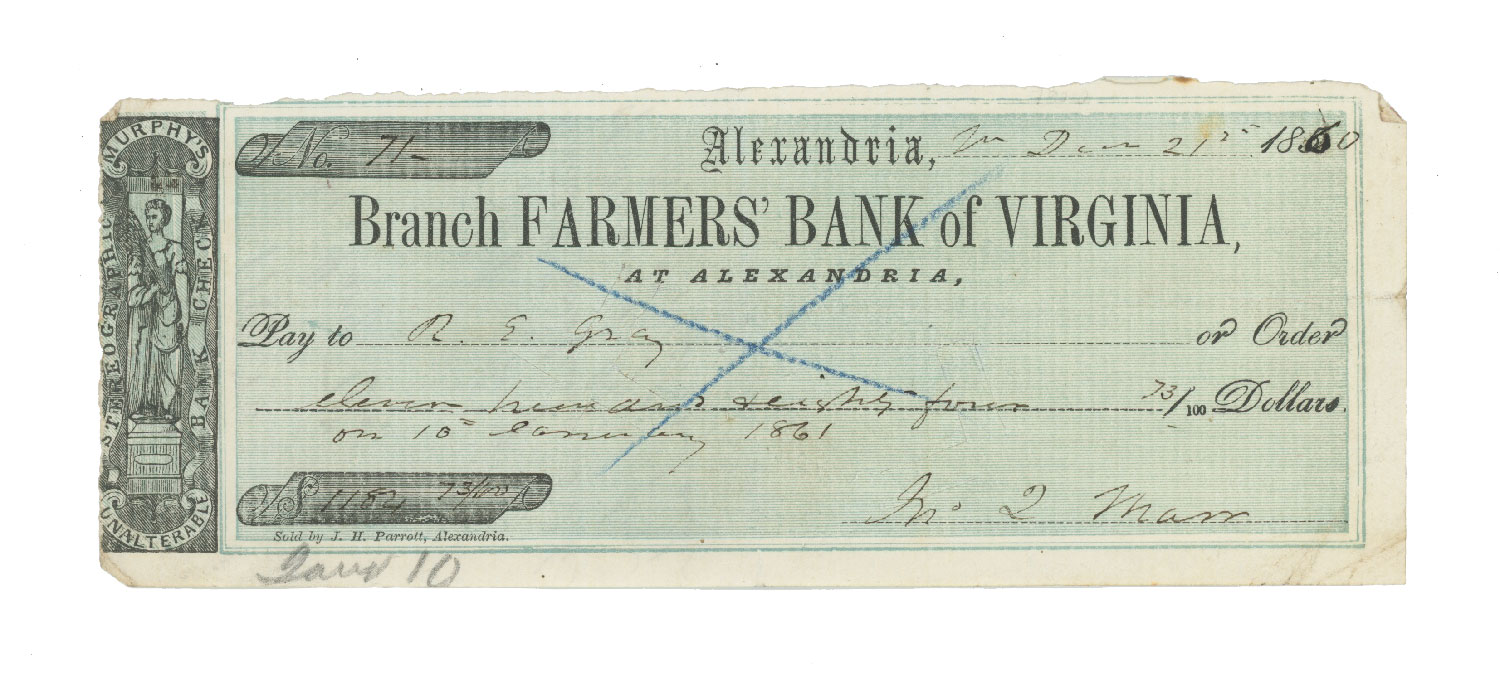1860 Check Signed by Captain John Quincy Marr, "Warrenton Rifles" - First Confederate Officer to be Killed by Union Soldier - Battle of Fairfax Court House - June 1, 1861
1860 Check Signed by Captain John Quincy Marr, "Warrenton Rifles" - First Confederate Officer to be Killed by Union Soldier - Battle of Fairfax Court House - June 1, 1861
Item No. 5874354
An 1860 cancelled check signed by Captain John Quincy Marr of the “Warrenton Rifles,” who at the Battle of Fairfax Court House on June 1, 1861, became the first Confederate officer to be killed in battle by a Union soldier in battle. The check was made out to R. E. Gray and was drawn on the Farmer’s Bank of Virginia at Alexandria for $1,184.73. Gray’s endorsement is on the reverse.
Marr had formed the Warrenton Rifles after John Brown’s Harpers Ferry raid. From his biography on Wikipedia:
On Saturday, June 1, 1861, a company of Union Army cavalry on a scout entered the streets of Fairfax Court House after driving back one Confederate picket and taking another prisoner. At that time, two companies of cavalry and Marr's Warrenton Rifles infantry company occupied the town. The Confederate cavalry began to retreat and cut off part of the Warrenton Rifles from those who faced the Union cavalry charge. Only about 40 men from the company were in a position to combat the Union cavalrymen.
Lieutenant Charles Henry Tompkins of the 2d U.S. Cavalry Regiment led the Union force of between 50 and 86 men who separated into two groups as they rode through the village. Captain Marr challenged the riders, asking "What cavalry is that?" These were his last words. Scattered shots were fired as the Union cavalry rode through and Captain Marr fell dead. Marr was not in the immediate presence of any of his men on a dark night so soon after he fell, no one knew where he was or what may have happened to him. His body was found later in the morning.
After Marr fell, first appeared former and subsequent Virginia governor and later major general William "Extra Billy" Smith, who had just resigned his seat in the U.S. Congress. He was from Warrenton and had helped raised the company. He took command in the absence of the company's leaders. Soon thereafter Lieutenant Colonel (later Lieutenant General) Richard S. Ewell, who had just been placed in charge of Confederate forces at Fairfax Court House, came upon the company. Lt. Col. Ewell had received a shoulder wound as he emerged from the village's hotel as the Union force first rode through the streets so he was bleeding as he took charge of the infantry company in the field and redeployed 40 of them. Ewell soon went off to send for reinforcements and Smith redeployed the men again in the same general area but in a less exposed position about 100 yards forward. After the Union cavalry rode through the village, they regrouped and returned through the village streets. A volley from the redeployed men of the Warrenton Rifles turned them back. The Confederates fired additional volleys at the Federals as they tried to pass through town again on their way back to their base near Falls Church, Virginia. After a third failed attempt to ride past the Confederates, the Union men were forced to leave town toward Flint Hill in the Oakton area of Fairfax County to the north of the City of Fairfax with several wounded men.
Confederate casualties in the affair were one dead, four wounded (including Lt. Col. Ewell), one missing, according to their report. A later account states that only two were wounded, but five were captured. The Union force lost one killed, four wounded (including Lt. Tompkins) and three missing, who had been taken prisoner. The Union soldier killed was identified as Private Saintclair. Governor Smith later reported that Marr had apparently been hit by a spent round ball because he had a large bruise above his heart but his skin had not been penetrated.
The check measures about 7 1/4” x 2 3/4” and is in excellent condition. There is a cancellation hole on the right side extending from “four” to “Jno.” Minor toning.


